Und aktuell? Wir sprechen gerade über die nächste Stufe: Ein 17-plex – ohne Zyklisierung. Das bedeutet: alle Marker gleichzeitig, ohne Zwischenschritte. Ambitioniert, aber extrem spannend. #Forschung #Multiplexing #Organoide #Immunfluoreszenz #LehreUndLabor
#multiplexing
Interesting imaging multiplexing method: Combinatorially label multiple protein species in several channels, then deconvolve them in software. Allows up to 7 proteins to be imaged in 3 channels.
Escalating High-dimensional Imaging using Combinatorial Channel Multiplexing and Deep Learning
Ben-Uri et al., preprint at biorxiv 2024
https://doi.org/10.1101/2023.09.09.556962
This feels like the opposite of #multiplexing from software licensing terms:
"Amazon is encouraging its employees to create multiple GitHub accounts and share their access credentials."
Oh well, if the #AWS legal team says "this is fine", it must be.😇
#Multiplexing technique for 7-segment displays.
The first GIF features a slomo view of a VFD calculator display in action.
The second GIF provides a schematic overview of the multiplexing process.
Multiplexing allows to control multiple digits using fewer output pins.
It was fun filming the display after restoring this non-working calculator and uncovering what wasn't visible to the naked eye. 🔍 🎥 👀
Go-like каналы на C++
Привет, habr! Предлагаю вашему вниманию статью о том, как я писал велосипед библиотеку для передачи сообщений между потоками с возможностью мультиплексирования. Смотреть мой велосипед
https://habr.com/ru/articles/805561/
#с++17 #с++_программирование #channel_api #multiplexing
#Microscopy method overcomes the traditional resolution limit for the fast co-tracking of #molecules.
#biomolecules #fluorescence #pMINFLUX #multiplexing
https://phys.org/news/2024-02-microscopy-method-traditional-resolution-limit.html
Interesting #multiplexing datapoint: This preprint describes a straightforward multiplex #microscopy strategy - Image 3 channels, blast sample with bright light until it's bleached, then re-stain. Works with 400 µm sections in fructose-based #tissueclearing solution.
Increased multiplexity in optical tissue clearing-based 3D immunofluorescence microscopy of the tumor microenvironment by LED photobleaching
Zheng et al., preprint at biorxiv 2023
https://www.biorxiv.org/content/10.1101/2023.11.29.569277v2?ct=
Hey, remember when I said that #HTTP2's spec doesn't require TLS for it to be used, but de-facto it is necessary anyway because mainstream browsers like #Firefox and #Chrome will not support #HTTP/2 without #HTTPS?
Well I just realized now that thanks to #Mozilla and #Google's arbitrary limitations, they've actually made browsing the web with #I2P, #Tor (via onion/hidden services), and #Yggdrassil slower than it should be! The latency in Tor is so damn high that you essentially have to sacrifice speed if you're going to use an onion service that doesn't have an HTTPS certificate (which is unnecessary in the #encryption front because your connection to the onion is already encrypted!).
And I'm not even alone in this thought, look at this comment in bug 1418832 which never got a response from Mozilla.
Basically if you're a Tor hidden service operator, Firefox's devs are telling you to chalk up that $30 TLS certificate from harica.gr for the HTTP/2, and if you're operating a website over I2P or Yggdrasil, well "fuck your #privacy, get stuck in HTTP/1.1 lol"
I normally dunk on HTTP/2 (and personally I'm not even a fan of Tor) but this stupid decision by Mozilla as well as the equally stupid decision to drop HTTP/1.1 #pipelining means downstream (which Tor Browser is) will have to deal with this bullshit speed bump. HTTP/2's #multiplexing would've helped greatly in these average high latency situations!
This is why you never let politician-wannabes control your development
😶 Tecnologia dei chip a onde millimetriche
👉 https://gomoot.com/tecnologia-dei-chip-a-onde-millimetriche/
#5g #chip #Fujitsu #multiplexing #multiraggio #wireless @Fujitsu
Single cell omics #singlecellomics from bench to bedside: conference and workshop at KU Leuven in Belgium. Two days of technology and application in October give a deep insight in the nuts-and-bolts of the current state of the art. Meet Abhishek Garg, Yvan Saeyes, Sabine Tejpar, Baki Topal, Jessica Roelands, Steven de Vleeschouwer and more @cyrilpedia @chfloudas #biology #transcriptomics #proteomics #multiplexing #tissue #clinics #standardization #data #highDimensional
https://gbiomed.kuleuven.be/english/research/50000622/single-cell-course
Imaging is a powerful tool in cancer research. Join our latest masterclass and discover the latest imaging techniques, get expert tips, and see how leading researchers are using them to drive new insights into cancer.
☑️ Register now!
https://bitesizebio.com/cancer-imaging-masterclass/?nlc=SoMeMastodon
#masterclasses #cancer #tumor #microenvironment #multiplexing #FRET #FLIM #AI #electronmicroscopy
🙌 A new partnership between Cell Signaling Technology (CST) and Leica Microsystems gives spatial biology researchers using Cell DIVE a way to design their #multiplexing studies quickly, knowing that they can count on the quality and reliability of validated antibodies from CST.
Full story: https://fcld.ly/10rc3ky
#ScienceTwitter #ScienceMastodon #CancerReserarch #Microscopy
[Getting Rid Of] The Ghost In the LED
Multiplexing is a very old technology in which control signals are intermixed for the sake of being able to control more devices than there are control signals. For [mihai.cuciuc], the problems started when he multiplexed some very efficient LED's, and it's all well described on his Hackaday.io page.
The problem? In two banks of six LEDs each, both LEDs connected to a single Arduino pin would light, even when only one bank was turned on at the ground side. The LED In the bank that was switched on lit brightly, and its corresponding LED in the bank that was off would also be very dimly lit. [mihai] was able to determine that the problem was not due to a leaky transistor, but rather due to a quality of the LED's themselves.
What is an LED but a diode, and it's well known that diodes also have capacitance. In fact, this quality is exploited in varactor diodes, a specialty diode whose capacitance can be changed by varying the voltage on the cathode. [mihai] deduced that this capacitance was causing current to flow in the bank that was off. Where was the current going? From the Arduino pin that was on, through its attached LED, and then into the rest of the bank of LED 's, charging them like capacitors. [mihai] hasn't seen this before, but theorizes that for the latest batch of high efficiency LED's, this minute current is enough to light the LED through which the current is flowing.
[mihai]'s solution is an elegant hack which he's made available for your perusal. You might also enjoy this introduction to diode basics by W2AEW. If you have any great diode or LED hacks of your own, be sure to drop us a line!
#ledhacks #diodecapacitance #diodehacks #highefficiency #led #multiplex #multiplexing
Displays have come a long way in the last few decades, but none can deliver the mesmerizing visual and audio experience of a large flip dot display. Both old panels and new panels can be expensive and difficult to source, so [Larry Builds] made his own flip dots with the help of 3D printing.
Flip dots are driven by a pair of electromagnetic posts that attract or repel a magnet embedded in the dot, and [Larry Builds] version is no different. For the electromagnets, he used M3 threaded rod with enamel wire wound around them using a drill. At first, he used a large magnet in the center of the 3D printed dot, but the magnetic field was large and strong enough to flip the surrounding dots in an array. He then changed the design to a small 4 mm diameter magnet in the edge that aligns directly with the electromagnets. This design looks very similar to those used by Breakfast for their massive installations. By modifying electromagnets and adding spacers around the magnets, he was able to reduce the operating current from 2 A to below 500 mA. [Larry Builds] also breadboarded a basic driver circuit consisting of H-bridges multiplexed to rows and columns with diodes.
We will be keeping a close eye on this project, and we look forward to seeing it evolve further. It's definitely on our "things to build" list. We've embedded multiple videos after the break showing the progress thus far.
We've covered several interesting flip dot projects, including a water level indicator that doesn't use any electronics and another that is crocheted.
Thanks for the tip [Baldpower]!
#3dprinterhacks #mischacks #3dprinted #eletromagnet #flipdisc #flipdotdisplay #hbridge #multiplexing
Prioritising Mechanical Multiplexer
When automating almost any moderately complex mechanical task, the actuators and drive electronics can get expensive quickly. Rather than using an actuator for every motion, mechanical multiplexing might be an option. [James Bruton] has considered using it in some of his many robotics projects, so he built a prioritizing mechanical multiplexer to demonstrate the concept.
The basic idea is to have a single actuator and dynamically switch between different outputs. For his demonstration, [James] used a motor mounted on a moving platform actuated by a lead screw that can engage a number of different output gears. Each output turns a dial, and the goal is to match the position of the dial to the position of a potentiometer. The "prioritizing" part comes in where a number of outputs need to be adjusted, and the system must choose which to do first. This quickly turns into a task scheduling problem, since there are a number of factors that can be used to determine the priority. See the video after the break to see different algorithms in action.
Instead of moving the actuator, all the outputs can connect to a single main shaft via clutches as required. Possible use cases for mechanical multiplexers include dispensing machines and production line automation. Apparently, the Armatron robotic arm sold by Radioshack in the '80s used a similar system, controlling all its functions with a single motor.
[James] knows or two about robotics, having built many of them over the last few years. Just take a look at OpenDog and his Start Wars robots.
if i want to use this sweet new rig i've got to leap to #neovim. perhaps I could extend my desktop but honestly multiple clients makes more sense at this point, is a #multiplexing skill i need.
Weird charlieplexing with capacitors and diodes? [2019-02-10] https://diode.zone/videos/watch/7b3dc76c-2f28-44cb-b82a-8f067493ff1a
4-port USB sharing switch, three wire control (part 2) [2019-02-08] https://diode.zone/videos/watch/a6b5e7ea-3f8e-4a07-9b82-aac770799ab0


